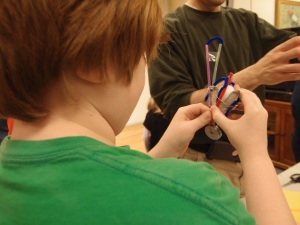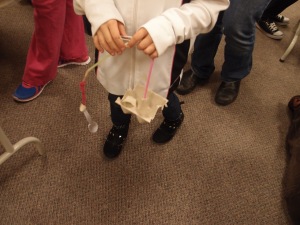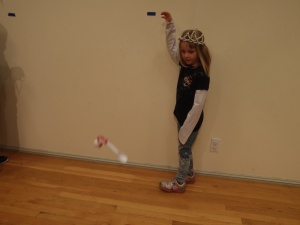 For our March Engineering Challenge we built devices that would carry a ping pong ball down a piece of fishing line. I got the original idea from a PBS Kids Design Squad activity, which I then adapted a bit for a wider age range. The original challenge suggested using 4-5 feet of fishing line, as less was too short and more was likely to sag. I didn’t measure exactly, but I know the width of the stage area in our meeting room is about as wide as I am tall, which makes it roughly 5 feet.
For our March Engineering Challenge we built devices that would carry a ping pong ball down a piece of fishing line. I got the original idea from a PBS Kids Design Squad activity, which I then adapted a bit for a wider age range. The original challenge suggested using 4-5 feet of fishing line, as less was too short and more was likely to sag. I didn’t measure exactly, but I know the width of the stage area in our meeting room is about as wide as I am tall, which makes it roughly 5 feet.
The children were given straws, pipe cleaners, paper clips, egg cartons, spoons, washers, paper, and tape. The initial challenge was simply to build something that would carry the ping pong ball down to the bottom of the line. I had a whole “and the stage is made of pingpong lava, that doesn’t hurt you, but will burn up your pingpong ball!” story to help forestall the inevitable wise-guy just letting the ball fall and bounce to the end of the stage. My audience skewed younger – of the 30+ kids, I’d say at least 20 appeared to be 8 or younger – and they really bought into the lava story with enthusiasm.
With my engineering challenges I like to have multiple levels of challenge. Once a child has completed the first level, I give  him or her the second challenge. This way I can differentiate everyone’s experience, allowing everyone to walk away feeling successful. Some kids will only complete the first level, other kids will complete several. For this challenge, the second level was supposed to be similar to the PBS Design Squad rules, which was to make the ping pong ball travel to the bottom in less than 4 seconds. However, I ran into a problem, in that all of the vehicles managed to do this on the first build, essentially erasing it as a challenge.
him or her the second challenge. This way I can differentiate everyone’s experience, allowing everyone to walk away feeling successful. Some kids will only complete the first level, other kids will complete several. For this challenge, the second level was supposed to be similar to the PBS Design Squad rules, which was to make the ping pong ball travel to the bottom in less than 4 seconds. However, I ran into a problem, in that all of the vehicles managed to do this on the first build, essentially erasing it as a challenge.
At first, I thought perhaps the lines were not at the right angle. The original challenge also suggested an angle of about 30 degrees. Re-evaluating the lines, I decided they were probably more like 45 degrees. I lowered two of the four lines to be closer to 30 degrees, but that didn’t seem to make much of a difference. I decided to change the second challenge to be to see how slowly you could make the ping pong ball go down the line.
 The older kids seemed to really get into the challenge of making it go slowly, and were pleased with their results. At the beginning of the event, I had emphasized that the Engineering Process involves constantly testing your design and then going back to improve it. I was trying to forestall frustration in what I had initially deemed to be a true challenge for the younger-than-average audience, but apparently the kids took the message to heart. Despite the fact that it actually ended up being a fairly straight-forward challenge, many of the children went back and redesigned their vehicles, even after meeting with success, so that they could “be the best possible.” Some of the children spent a lot of time each designing several separate vehicles using different materials so that they could determine which one worked the best. Most of the children were so caught up on redesigning and recreating that they never came to me for a second level of challenge, but that was more than okay, as the point of the exercise was to have fun, feel confident about building things, and walk away thinking like an engineer, all of which were clearly accomplished.
The older kids seemed to really get into the challenge of making it go slowly, and were pleased with their results. At the beginning of the event, I had emphasized that the Engineering Process involves constantly testing your design and then going back to improve it. I was trying to forestall frustration in what I had initially deemed to be a true challenge for the younger-than-average audience, but apparently the kids took the message to heart. Despite the fact that it actually ended up being a fairly straight-forward challenge, many of the children went back and redesigned their vehicles, even after meeting with success, so that they could “be the best possible.” Some of the children spent a lot of time each designing several separate vehicles using different materials so that they could determine which one worked the best. Most of the children were so caught up on redesigning and recreating that they never came to me for a second level of challenge, but that was more than okay, as the point of the exercise was to have fun, feel confident about building things, and walk away thinking like an engineer, all of which were clearly accomplished.